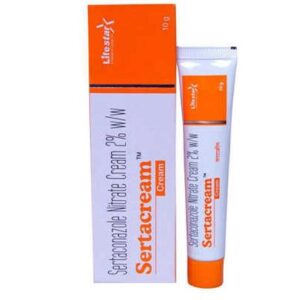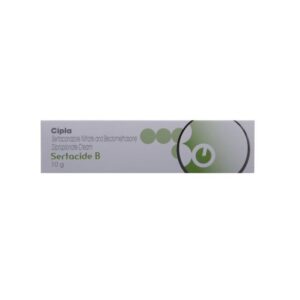BECLOMETHASONE + SERTACONAZOLE NITRATE
Beclomethasone: Beclomethasone is a medication that belongs to the category of glucocorticoids. It is commonly used as an anti-inflammatory agent and is primarily used to treat respiratory conditions such as asthma and allergic rhinitis.
The mechanism of action of beclomethasone involves its ability to bind to glucocorticoid receptors present in the cells. This binding leads to the activation of these receptors, resulting in the regulation of gene expression. As a result, the production of various inflammatory substances is suppressed, leading to a reduction in inflammation and improvement in symptoms.
Beclomethasone is available in various forms, including inhalers for asthma and nasal sprays for allergic rhinitis. The dose of beclomethasone depends on the specific formulation and the condition being treated. It is essential to follow the instructions provided by the healthcare professional or indicated on the medication label.
Common side effects of beclomethasone include irritation in the nose or throat, nosebleeds (with nasal spray), and hoarseness or throat irritation (with inhalers). These side effects are mostly mild and temporary, and they can often be minimized by using the medication correctly, such as rinsing the mouth after inhalation. Rarely, beclomethasone may cause more severe side effects, such as systemic effects including adrenal suppression, growth delay in children, and increased susceptibility to infections.
It is crucial to note that beclomethasone is a prescription medication, and it is necessary to consult a healthcare professional before starting or stopping the treatment. They can provide specific instructions based on the individual’s condition and medical history.
Sertaconazole Nitrate: Sertaconazole Nitrate is an antifungal medication used to treat fungal infections of the skin, such as ringworm (tinea corporis), athlete’s foot (tinea pedis), and jock itch (tinea cruris). It belongs to the class of drugs known as imidazoles.
The exact mechanism of action of Sertaconazole Nitrate is not fully understood, but it is believed to work by inhibiting the synthesis of ergosterol, a critical component of the fungal cell membrane. By doing so, it disrupts the fungal cell wall, leading to its death.
This medication is available in topical cream or lotion form and is applied directly to the affected area of the skin. The recommended dose and duration of treatment vary depending on the severity and location of the infection. It is important to follow the instructions provided by your healthcare provider or read the product label carefully.
Common side effects of Sertaconazole Nitrate include mild irritation, burning, itching, or redness at the application site. These side effects are usually temporary and subside with continued use. However, if these symptoms persist or worsen, it is advisable to consult a healthcare professional.
In rare cases, some individuals may experience more severe side effects such as allergic reactions, skin rash, or swelling. If any of these serious side effects occur, immediate medical attention should be sought.
It is important to note that Sertaconazole Nitrate should be used only as directed by a healthcare provider and should not be applied to broken or irritated skin. It is also advised to avoid contact with the eyes, nose, or mouth.



